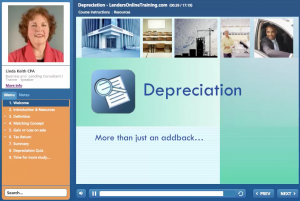Jake asks:
If a piece of equipment is financed and then expensed in the same year by way of a section 179 deduction, should I still ignore the section 179 deduction to calculate cash flow? I ask because the business didn’t actually spend the money because the equipment was financed but the section 179 deduction did reduce their net income. Or, should I just ignore the section 179 entirely and adjust ordinary business income by other cash and noncash (in the tax return) items to calculate cash flow?
Linda says:
Add back whatever depreciation has reduced your starting number, Jake. If you start with taxable income add back the depreciation on page one of that return. As it happens, depreciation on a Schedule C, F or 1120 does include Section 179. Depreciation an an 1120S or 1065 does not. Either way, add back whatever they deducted.
Was the capital expenditure financed?
If the item was financed you are set. There was no cash outflow and you have not counted depreciation against the borrower’s cash flow. Perfect.
In the unusual case where a significant equipment purchase was not financed, and you are doing historical instead of projected cash flow, that is the only time I might not add back depreciation. It has nothing to do with whether it was 179 or not, though. It recognizes that in that case, money was spent.
Here is an actual example, brought to me by a lender who had attended my Tax Return Analysis Training for Bankers. He reminded me I taught the bankers to add back depreciation as a non-cash item. But he had a long-distance truck driver who replaced the truck engine. He spent over $21,000 to do so and did it out of cash flow. Further, the truck driver explained that he does this about every three years. By adding back depreciation, the lender would be ignoring a $7,000 per year cash outflow, which was signficant for this borrower.
I agreed that since he was calculating a two-year analysis of cash flow, it made sense to add back 1/3rd and leave 2/3rds in. Because the borrower paid cash, and needed to do so on a recurring basis, adding back depreciation did not give the complete picture of debt payment capacity.
The type of depreciation is not relevant
Jake, for this question, the type of depreciation is not relevant. Add back all depreciation you have counted against them. Usually this is page one or Schedule C/F of the return. But with some software or worksheets, you actually enter depreciation figures from Schedule K on a pass-through entity or Schedule M-1 to reconcile to Net Income per Books. If your software or worksheet has you doing that, I am guessing (and hoping) it is smart enough to then add back all the depreciation it had you enter.
As to the issue of financed or not, try to determine the continuing cash outflow when a company is routinely using cash to purchase equipment. That will vary company to company.
Why don’t your guidelines say that?
In global cash flow analysis of tax returns, and for that matter, in financial statement analysis, we make simplifying assumptions all the time. The simplifying assumption that major expenditures of capital items are financed and thus, depreciation is a duplication of the expense, is a reasonable one. For almost any guideline or simplifying assumption you make, I can likely find a situation where it is not a good fit. So follow your guidelines, but keep your mind in gear for those times when following the guidelines may lead you astray.
Depreciation Module tells all!
Most lenders learn early on that depreciation is an add back. But why? When? Which? And are there any exceptions? Click here to get the Depreciation Module.
Or for the entire course and module list on Tax Return and Financial Statement Analysis, including 35 modules, three case studies and seven live webinars, click here. Our lenders report a 31% improvement in competence and confidence after taking the online course in Global Tax Return Analysis.

